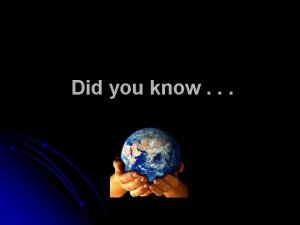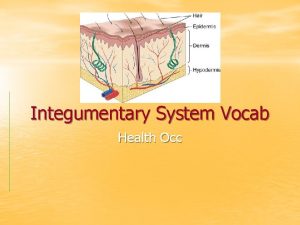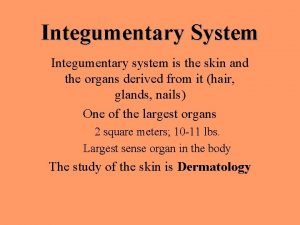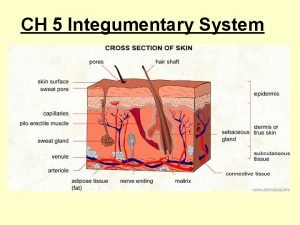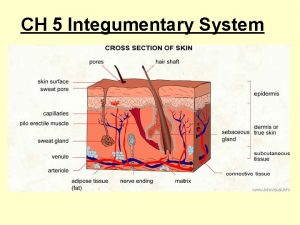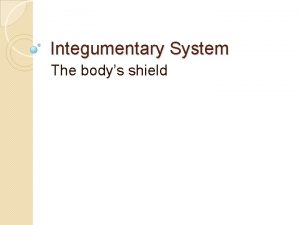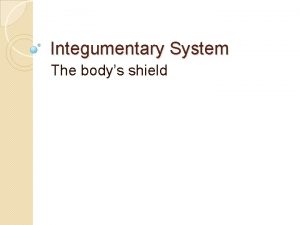INTEGUMENTARY SYSTEM Skin Did you know n The



















- Slides: 19

INTEGUMENTARY SYSTEM

Skin – Did you know? n The largest organ of the body - 21 square feet; 4 Kg/9 lbs – 15% of total body weight n Varies in thickness from 1/50 inch (0. 5 mm) in the eyelids to 1/4 inch (6. 3 mm) in the soles of the feet n Terms “derma” and “cutaneous” refer to the skin

One Square Inch n 20 Blood Vessels 65 Hairs & Hair Muscles 78 Nerves 78 Sensors for Heat 13 Sensors for Cold 160 Sensors for Pressure 100 Sebaceous/Oil Glands 1300 Nerve Endings 19, 500, 000 Cells 0. 5 Million Cells Dying & Being Replaced

Structure and Function n Integumentary system is composed of the skin and accessory structures – hair, nails and glands n Functions of the integumentary system n Protection – barrier to ultraviolet rays, microbes, dirt, chemicals; shock absorber n Sensory perception – pain, pressure, temperature and touch n Temperature Regulation: blood vessels near surface constrict or dilate n Storage – fat, glucose, water, vitamins, and salts. n Water Balance: prevents loss of water and absorption (our wet suit) n Waste Excretion (eliminates oil, salt, water, CO 2 etc) n Production – Vitamin D

Skin Structures Ref: Gerdin, J. Health Careers Today, 3 rd edition, 2003, Mosby

Layers of Skin n Epidermis: Most Superficial n Dermis: Tough, Leathery Fibrous Connective Tissue; Only Part That is Vascularized n Subcutaneous(Hypodermis): Superficial Fascia; Mostly Fat (Insulate & Absorb Shock); Anchors Skin to Underlying Structures

Accessory Organs of the Skin n Hair n Nails n Sweat Glands n Sebaceous Glands

Hair and Hair Follicles n Skin has hair in all areas except the soles of the feet n n and palms of the hands Hair serves to block foreign particles from entering the body and helps retain heat Hair fibers are rod like structures composed of tightly fused dead protein cells filled with hair keratin The visible portion is called the shaft The hair follicle are the sacs that hold the root of hair fibers. The erector muscles are tiny muscle fibers that cause the hair to stand erect. Goose bumps reduce heat loss

Nails Ø Nails composed of dead, keratinized, epidermal epithelial cells that grow under the lunula (white portion of the nailbed) Ø Cells that form the nail bed are linked together and form the nail. Nail is replaced if nail bed is OK


Glands n Function is to help regulate the body temperature and excrete body wastes n Three types of glands in the skin n Sebaceous glands (oil) – usually open to hair follicles; produce sebum (oil that is antibacterial and antifungal); plugged = pimple Sudoriferous glands (sweat) – coiled tubes that extend thru dermis and open on the surface of the skin at the pores Ceruminous glands – produce cerumen (earwax)

ASSESSMENT n Color/pigmentation: n Melanin: only pigment made in the skin; yellowish to redbrown to black; synthesis depends on enzyme in melanocytes; racial differences in the amt of melanin made; local accumulations = freckles n Carotene: yellow to orange hue esp. visible on palms and soles n Abnormal colors: erythema, cyanosis, pallor, jaundice, etc n Temperature n Moisture/Turgor n Texture/thickness

Medical Specialties Related to Integumentary System n Dermatologist – diagnoses and treats disorders of the skin n Cosmetic/Plastic surgeon – specializes in the surgical restoration and reconstruction of body structures. (Plastic refers to plasty = surgical repair)

Diagnostic Procedures for Skin

Direct Examination Good lighting required n Distribution of lesions (local or general) n When lesions are most bothersome n Changes in patient’s way of living n Wood’s light (for ringworm) n Microscopic exam for scales or fungi n

Sensitivity Tests n Patch test n Percutaneous test (scratch test) n Intradermal test

Biopsy Dermal punch n Examined by histologist or pathologist n

CLASSIFICATION OF SKIN LESIONS n Macule - Flat, discolored spot or patch of skin (i. e. , freckles) n Papule - Elevated, solid lesion of the skin n Nodule - Circumscribed, elevated and mainly solid lesion which is located deep in the dermis or subcutaneous tissue n Wheal- Smooth, slightly elevated, swollen area; solid elevation from an accumulation of fluid; usually redder or paler than the surrounding area and accompanied by itching (e. g. , insect bite) n n Plaque- Elevated, disc-shaped lesion Crust – a collection of dried serum and cellular debris (SCAB) Nevi – also known as moles Scale – flaking or dry patch made up of excess dead epidermal cells

CLASSIFICATION OF SKIN LESIONS (continued) n Contusion – injury that does not break the skin; characterized by swelling, discoloration, and pain n Ecchymosis = bruise; caused by bleeding within the skin n Petechiae = small pinpoint hemorrhages
 Did you went or did you go
Did you went or did you go Thin skin vs thick skin
Thin skin vs thick skin Thin skin vs thick skin
Thin skin vs thick skin Milady basic facial steps
Milady basic facial steps Did you know facts about tea
Did you know facts about tea Reported speech must
Reported speech must Fun facts about minecraft
Fun facts about minecraft Did you know
Did you know What did you do last night ?
What did you do last night ? Friend suffix words
Friend suffix words Walmart shrinkage statistics
Walmart shrinkage statistics Finally false friend
Finally false friend How do you pronounce integumentary
How do you pronounce integumentary Glands in integumentary system
Glands in integumentary system Integumentary system vocabulary
Integumentary system vocabulary Swine integumentary system
Swine integumentary system Integumentary system adalah
Integumentary system adalah Integumentary system facts
Integumentary system facts Exercise 7 the integumentary system
Exercise 7 the integumentary system Integumentary system vocab
Integumentary system vocab







